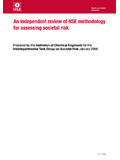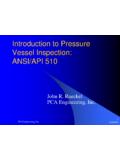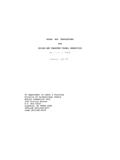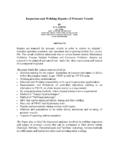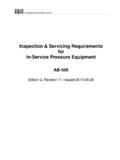Transcription of Pressure systems at work: A brief guide to safety …
1 Health and safety Executive Pressure systems A brief guide to safety introduction Pressure systems If Pressure equipment fails in use, it can seriously injure or kill people nearby and A brief guide to safety cause serious damage to property. This leaflet describes what employers need to do to minimise the risks when working with systems or equipment which contain a liquid or gas under Pressure . It will also be useful to employees and their safety representatives. As an employer or self-employed person, you have a duty to provide a safe workplace and safe work equipment. Designers, manufacturers, suppliers, installers, users and owners also have duties. The leaflet does not cover gas cylinders (now called transportable Pressure This is a web-friendly version receptacles or transportable Pressure vessels), or tanks and tank containers.
2 Of leaflet INDG261(rev2), published 11/12 The main regulations covering Pressure equipment and Pressure systems are the Pressure Equipment Regulations 1999 and the Pressure systems safety Regulations 2000. Employers have a further duty to consult any safety or employee representatives on health and safety matters. Where none are appointed, employers should consult the workforce direct. Examples of Pressure systems and equipment are: boilers and steam heating systems ;. pressurised process plant and piping;. compressed air systems (fixed and portable);. Pressure cookers, autoclaves and retorts;. heat exchangers and refrigeration plant;. valves, steam traps and filters;. pipework and hoses; and Pressure gauges and level indicators. Principal causes of incidents are: poor equipment and/or system design;. poor maintenance of equipment.
3 An unsafe system of work;. operator error, poor training/supervision;. poor installation; and inadequate repairs or modifications. Page 1 of 5. Health and safety Executive The main hazards are: impact from the blast of an explosion or release of compressed liquid or gas;. impact from parts of equipment that fail or any flying debris;. contact with released liquid or gas, such as steam; and fire resulting from the escape of flammable liquids or gases. Reduce the risk of failure The level of risk from the failure of Pressure systems and equipment depends on a number of factors including: the Pressure in the system ;. the type of liquid or gas and its properties;. the suitability of the equipment and pipework that contains it;. the age and condition of the equipment;. the complexity and control of its operation;. the prevailing conditions (eg a process carried out at high temperature); and the skills and knowledge of the people who design, manufacture, install, maintain, test and operate the Pressure equipment and systems .
4 To reduce the risks you need to know (and act on) some basic precautions, some of which are contained in the Pressure systems safety Regulations 2000 and the Pressure Equipment Regulations 1999. Provide safe and suitable equipment When installing new equipment, ensure that it is suitable for its intended purpose and that it is installed correctly. This requirement can normally be met by using the appropriate design, construction and installation standards and/or codes of practice. Since 2002, most Pressure equipment placed on the market has had to meet the requirements of the Pressure Equipment Regulations 1999. For Pressure equipment not covered by the Pressure Equipment Regulations 1999, the more general requirements of the Pressure systems safety Regulations 2000 apply. The Pressure system should be designed and manufactured from suitable materials.
5 You should make sure that the vessel, pipes and valves have been made of suitable materials for the liquids or gases they will contain. Ensure the system can be operated safely without having to climb or struggle through gaps in pipework or structures, for example. Be careful when repairing or modifying a Pressure system . Following a major repair and/or modification, you may need to have the whole system re-examined before allowing the system to come back into use. Know the operating conditions Know what liquid or gas is being contained, stored or processed, for example is it toxic/flammable? Know the process conditions, such as the pressures and temperatures. Know the safe operating limits of the system and any equipment directly linked to it or affected by it. Ensure there is a set of operating instructions for all the equipment and for the control of the whole system including emergencies.
6 Ensure that appropriate employees have access to these instructions, and are properly trained in the operation and use of the equipment or system (see the section on training below). Pressure systems : A brief guide to safety Page 2 of 5. Health and safety Executive Fit suitable protective devices and ensure they function properly Ensure suitable protective devices are fitted to the vessels, or pipework (eg safety valves and any electronic devices which cause shutdown when the Pressure , temperature or liquid or gas level exceed permissible limits). Ensure the protective devices have been adjusted to the correct settings. If warning devices are fitted, ensure they are noticeable, either by sight or sound. Ensure protective devices are kept in good working order at all times. Ensure that, where fitted, protective devices such as safety valves and bursting discs discharge to a safe place.
7 Ensure that, once set, protective devices cannot be altered except by an authorised person. Carry out suitable maintenance All Pressure equipment and systems should be properly maintained. There should be a maintenance programme for the system as a whole. It should take into account the system and equipment age, its uses and the environment. Look for tell-tale signs of problems with the system , eg if a safety valve repeatedly discharges this could be an indication that either the system is over- pressurising or the safety valve is not working correctly. Look for signs of wear and corrosion. systems should be depressurised before maintenance work is carried out. Ensure there is a safe system of work, so that maintenance work is carried out properly and under suitable supervision. Further guidance on regulation 11 (Operation) and regulation 12 (Maintenance) of the Pressure systems safety Regulations 2000 is given in the Approved Code of Practice safety of Pressure systems .
8 (See Find out more'.). Make provision for appropriate training Everybody operating, installing, maintaining, repairing, inspecting and testing Pressure equipment should have the necessary skills and knowledge to carry out their job safely so you need to provide suitable training. This includes all new employees, who should have initial training and be supervised closely. Additional training or retraining may be required if: the job changes;. the equipment or operation changes; or skills have not been used for a while. Have the equipment examined Under the Pressure systems safety Regulations 2000, a written scheme of examination is required for most Pressure systems . Exempted systems are listed in the Regulations. Generally speaking, only very small systems are exempted. The written scheme should be drawn up (or certified as suitable) by a competent person.
9 It is the duty of the user of an installed system and the owner of a mobile system to ensure that the scheme has been drawn up. You must not allow your Pressure system to be operated (or hired out) until you have a written scheme of examination and ensured that the system has been examined. Pressure systems : A brief guide to safety Page 3 of 5. Health and safety Executive The written scheme of examination must cover all protective devices. It must also include every Pressure vessel and those parts of pipelines and pipework which, if they fail, may give rise to danger. The written scheme must specify the nature and frequency of examinations, and include any special measures that may be needed to prepare a system for a safe examination. The Pressure system must be examined in accordance with the written scheme by a competent person.
10 For fired (heated) Pressure systems , such as steam boilers, the written scheme should include an examination of the system when it is cold and stripped down and when it is running under normal conditions. The key steps are: Decide what items of equipment and parts of the plant should be included in the scheme. This must include all protective devices. It must also include Pressure vessels, and parts of pipework, which if they failed could give rise to danger. The scheme must be drawn up (or certified as suitable) by a competent person. It must specify whether the examination is in-service or out-of-service and how often the system is to be examined. The system must be examined by a competent person in accordance with that scheme. Remember, an examination undertaken in accordance with a written scheme of examination is like an MOT for your car.









